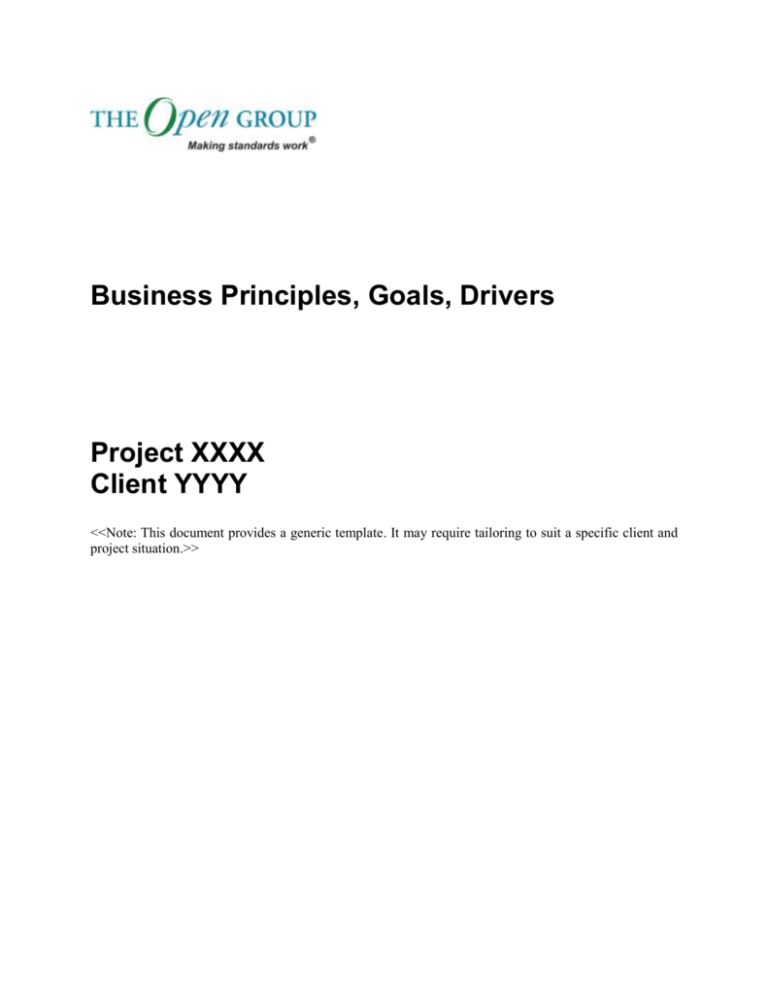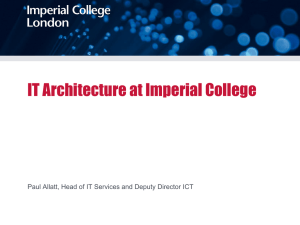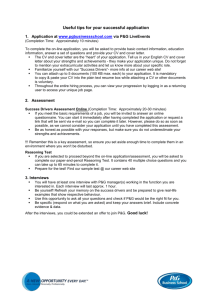
Business Principles, Goals, Drivers
Project XXXX
Client YYYY
<<Note: This document provides a generic template. It may require tailoring to suit a specific client and
project situation.>>
Table of Contents
1
2
3
4
Purpose of this Document .................................................................................................................................... 3
Business Principles .............................................................................................................................................. 4
Business Goals ..................................................................................................................................................... 5
Business Drivers .................................................................................................................................................. 7
Document Information
Project Name:
Project XXX
Prepared By:
Document Version No:
Business Principles, Goals, Drivers
Title:
Reviewed By:
0.1
Document Version Date:
Review Date:
Distribution List
From
To
Action*
Date
Phone/Fax/Email
Due Date
Phone/Fax/Email
* Action Types: Approve, Review, Inform, File, Action Required, Attend Meeting, Other (please specify)
Document Version History
Version
Number
Version
Date
Revised By
Description
TOGAF™ 9 Template: Business Principles, Goals, Drivers
Copyright © 2010 The Open Group. All rights reserved.
Filename
2
TOGAF™ is a trademark of The Open Group.
1
Purpose of this Document
This document describes business principles, business goals, and business drivers.
Business principles, business goals, and business drivers provide context for architecture work, by
describing the needs and ways of working employed by the enterprise. Many factors that lie outside the
consideration of architecture discipline may nevertheless have significant implications for the way that
architecture is developed.
The content and structure of business context for architecture is likely to vary considerably from one
organization to the next.
TOGAF™ 9 Template: Business Principles, Goals, Drivers
Copyright © 2010 The Open Group. All rights reserved.
3
TOGAF™ is a trademark of The Open Group.
2
Business Principles
2.1
Principles
Name
<Name of Principle>
Reference
<Unique identifier for the principle>
Statement
The Statement should succinctly and unambiguously communicate the fundamental rule. For
the most part, the principles statements for managing information are similar from one
organization to the next. It is vital that the principles statement be unambiguous.
Rationale
The Rationale should highlight the business benefits of adhering to the principle, using business
terminology. Point to the similarity of information and technology principles to the principles
governing business operations. Also describe the relationship to other principles, and the
intentions regarding a balanced interpretation. Describe situations where one principle would be
given precedence or carry more weight than another for making a decision.
Implications
The Implications should highlight the requirements, both for the business and IT, for carrying
out the principle – in terms of resources, costs, and activities/tasks. It will often be apparent that
current systems, standards, or practices would be incongruent with the principle upon adoption.
The impact to the business and consequences of adopting a principle should be clearly stated.
The reader should readily discern the answer to: “How does this affect me?” It is important not
to oversimplify, trivialize, or judge the merit of the impact. Some of the implications will be
identified as potential impacts only, and may be speculative rather than fully analyzed.
Mandatory/Advisory
Principle Review Reason
Review Date
<Reflects whether the principle
is mandatory (e.g., regulatory)
or advisory.>
<Circumstances under which the principle should be
reviewed in order to ensure its validity.>
<Latest review date.>
Name
<Name of Principle>
Reference
Statement
Rationale
Implications
TOGAF™ 9 Template: Business Principles, Goals, Drivers
Copyright © 2010 The Open Group. All rights reserved.
4
TOGAF™ is a trademark of The Open Group.
3
Business Goals
<<Provide a brief overview of the business context, with the focus on describing the key business
opportunity or goals to be addressed.>>
<<Topics to consider include:
Organization’s mission statement
Business goals (and changes)
Strategic plans of the business>>
3.1
Organization Mission Statement
View Name
Mission Statement
Stakeholder
Sponsor
Concern
Does the architecture clearly acknowledges the business mission? Is the architecture aligned to
the business mission?
Description
The business mission describes the rationale for existence of a business and outlines the
challenge facing the organization in achieving its goals in terms of: culture, market position,
capabilities, and growth. The mission reflects the desired goals of the entire organization, its
behavior, and what is important. It is intended to generate inspiration and aspiration within the
organization.
Whilst a mission statement must exist for the overall organization, it is possible for various
business units to create their own mission statements that help identify their contribution to the
overall goal.
Most mission statements are couched as a short description of the goal followed by a series of
statements that describe the manner in which the goal is to be achieved, for example:
“Improving people’s lives through the creation of choice.”
Some statements simply give the goal, for example:
“Do not be evil.”
Example mission statement is: “Setting the standard in helping our customers manage their
financial future.”
Guidance
Defined mission statements are contained within the appropriate artifact template in the
architecture content repository. If the relevant mission statements already exist, which should
be true for most projects, then this View is a simple selection from that. If not, the following
key points must be considered.
When deconstructing a higher-level business mission to formulate a mission statement
appropriate to a project or business unit there are several key point that should be considered:
Does the mission statement fully align with the higher-level business mission?
Do the defined goals fit within the goals hierarchy of the organization? If not, does the
organization expect the project to change its direction and goals hierarchy?
Does the statement clearly fit within the operational scope of the business unit or project?
Is the statement unambiguously formulated?
Does everyone agree on the definition?
Can the principles and constraints that the architecture, project/business unit must work
under be clearly related to the mission statement?
When a higher-level business mission is deconstructed to formulate a mission statement
appropriate to a business unit it must be considered also if the mission statement fully aligns
TOGAF™ 9 Template: Business Principles, Goals, Drivers
Copyright © 2010 The Open Group. All rights reserved.
5
TOGAF™ is a trademark of The Open Group.
with the higher-level Business mission. Defined mission statements are contained within the
appropriate artifact template in the architecture content repository. If the relevant mission
statements already exist, which should be true for most projects, then this View is a simple
selection from that.
Reference-ID
3.2
Business Mission Statement
Business Goals (and Changes)
Reference-ID
3.3
Title
Title
Business Goal
Strategic Plans of the Business
View Name
Business Strategy
Stakeholder
Sponsor
Concern
Does the Business Strategy to which the architecture is aligned match my expectations?
Description
The Business Strategy describes how an organization wants to achieve a business vision within
a given timeframe, and to some extent how it can be achieved.
This is a focused subset of the overall organization vision and goals and provides insight into
what the likely scope of the architecture will need to be. Strategy is the “what and how”
translation of the business vision or mission and describes how the business vision will be
reached.
Business Strategies are concerned with identifying the statements that set out the direction,
means, and key actions to achieve a subset of the organization’s objectives.
Strategy is the description of what, and on a high level how, the organization’s management
will achieve their goals.
The overall Business Strategy is usually very important to both the long and short-term goals
for the architecture. Architecture scope and objectives should align with the Business Strategy.
A specific business unit or program strategy is sometimes the key driver for a project. In this
case it is an architectural role to ensure that the project is implemented in a way that supports
the overall Business Strategy.
Guidance
The Business Strategy has to be SMART and formulated in terms of the results that have to be
achieved. Important strategic goals may be defined as Key Result Areas (KRAs).
The organization objectives need to be related to the KRAs within the roadmap to make
transparent what the tangible benefits of a target are, such as added value, responsiveness,
effectiveness. A KRA structure can also be applied in a solution outline, as part of the
justification for a project.
This View itself is a simple selection of the strategies. See the business strategies artefact
template for a list of attributes.
Reference-ID
Title
TOGAF™ 9 Template: Business Principles, Goals, Drivers
Copyright © 2010 The Open Group. All rights reserved.
Business Strategy Statement
6
TOGAF™ is a trademark of The Open Group.
4
Business Drivers
View Name
Business Drivers
Stakeholder
Sponsor
Concern
Do the Business Drivers to which the architecture is aligned, match my expectations?
Description
The impacts of environmental trends on an organization are described as the business drivers.
Another way to view business drivers is that they represent the business’ understanding of the
way the business must itself change in response to changes and trends in the environment.
The business drivers drive the creation of business strategies, and shape the architecture
principles. The business vision is the business’ estimate of where a set of expected changes and
trends in the environment and the responses to them will position the business at some future
time. The business vision can crystallize the business drivers, and thus the organization is in
control of and changes its own environment.
An example of an environment change creating business drivers:
“A new low-cost airline enters the market and the existing, high-cost carriers have to change
their business strategies to the new operating environment.”
An example of changing the environment creating business drivers:
“A company realizes that the airline market is dominated by high-cost carriers. It decides to
enter the market, defining a new niche for low-cost/no frills travel.”
Guidance
To be able to find all relevant business drivers for the project, the following list can help:
Competitive environment – e.g., emergence of powerful competitors with different
business models.
Regulatory environment – e.g., impact of US reporting requirements on foreign owned
businesses or trading partners.
Ownership environment – e.g., emergence of private equity firms, leading to different
expectations of returns.
Demand environment – e.g., high growth in acceptability and use of e-channels amongst
many customer segments.
Supply Environment – e.g., M&A in the supply base, leading to a shift in bargaining
power.
Resources environment – e.g., increased availability and capability of call centres in
Eastern Europe and Asia.
The attributes of the drivers themselves are described within the appropriate artifact template.
Reference-ID
Title
TOGAF™ 9 Template: Business Principles, Goals, Drivers
Copyright © 2010 The Open Group. All rights reserved.
Business Driver
7
TOGAF™ is a trademark of The Open Group.







